ENGT5219 Engineering Business Environment
VerifiedAdded on 2021/11/03
|11
|2789
|117
AI Summary
Contribute Materials
Your contribution can guide someone’s learning journey. Share your
documents today.
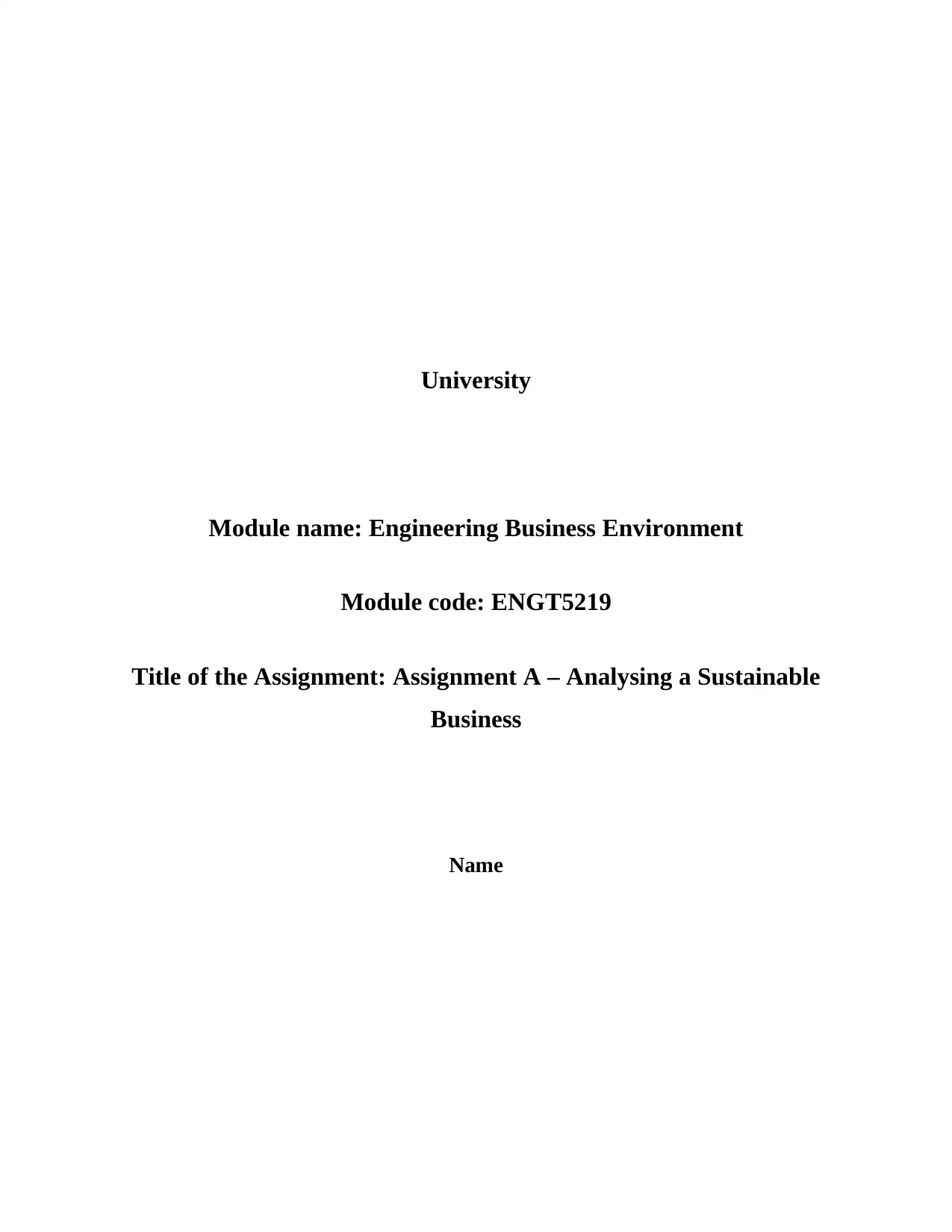
University
Module name: Engineering Business Environment
Module code: ENGT5219
Title of the Assignment: Assignment A – Analysing a Sustainable
Business
Name
Module name: Engineering Business Environment
Module code: ENGT5219
Title of the Assignment: Assignment A – Analysing a Sustainable
Business
Name
Secure Best Marks with AI Grader
Need help grading? Try our AI Grader for instant feedback on your assignments.
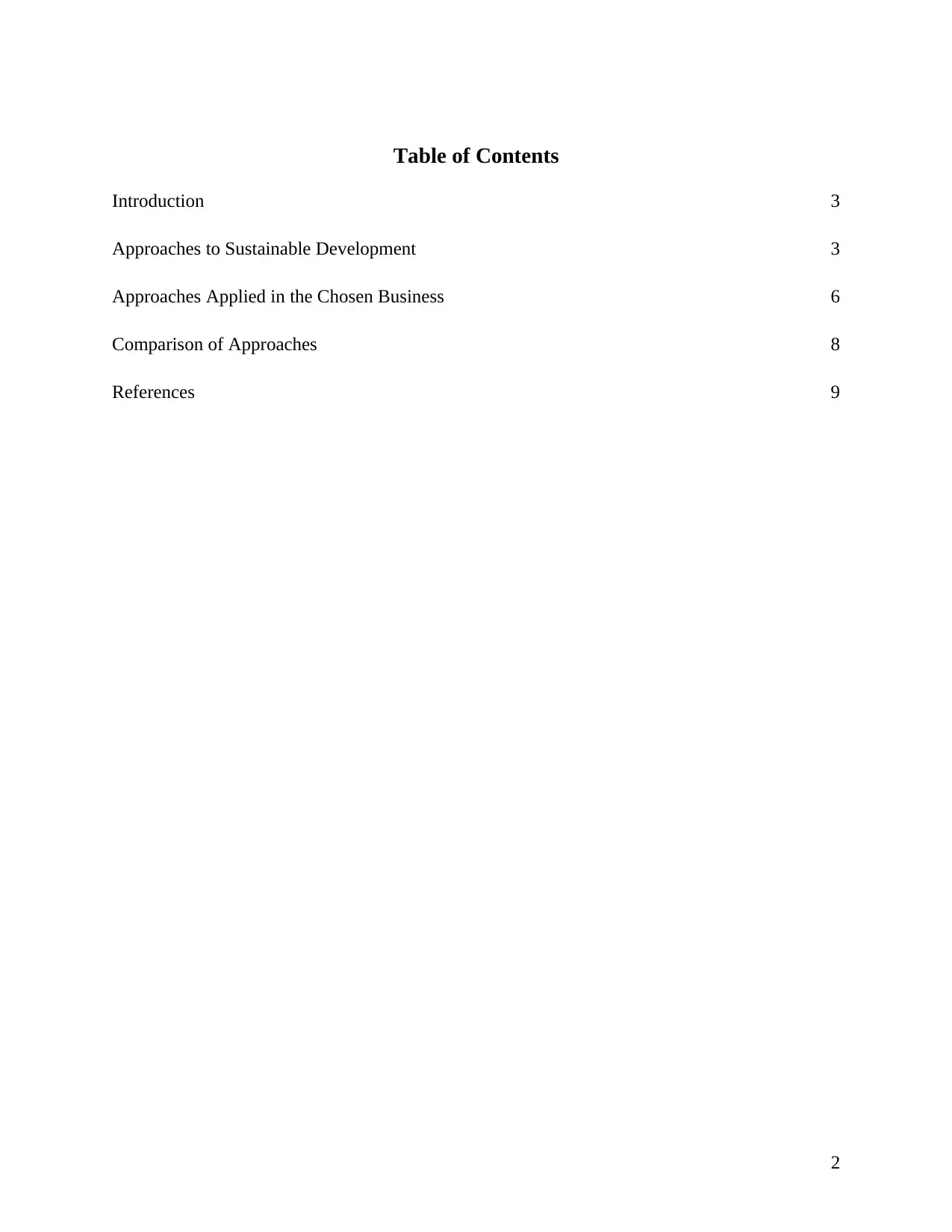
Table of Contents
Introduction 3
Approaches to Sustainable Development 3
Approaches Applied in the Chosen Business 6
Comparison of Approaches 8
References 9
2
Introduction 3
Approaches to Sustainable Development 3
Approaches Applied in the Chosen Business 6
Comparison of Approaches 8
References 9
2
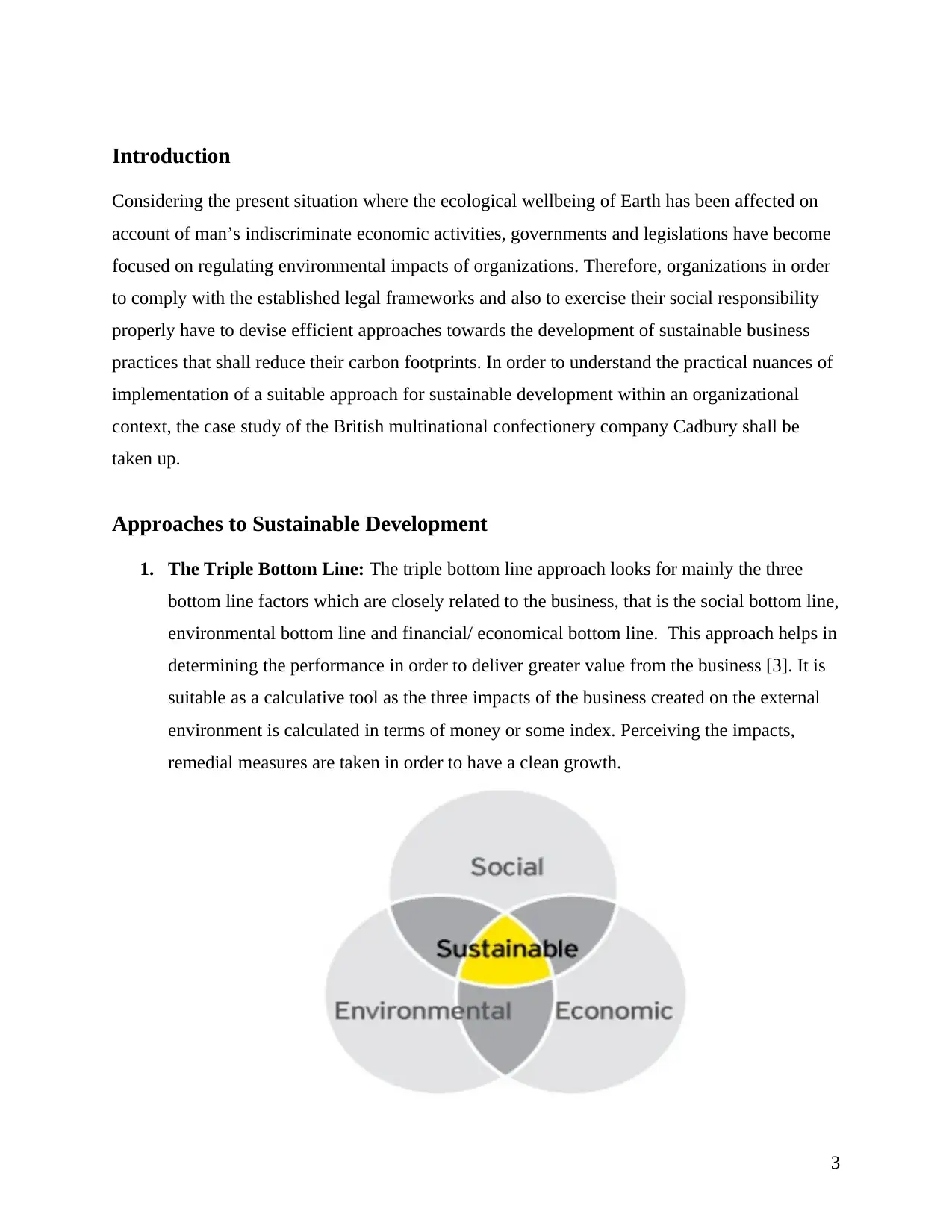
Introduction
Considering the present situation where the ecological wellbeing of Earth has been affected on
account of man’s indiscriminate economic activities, governments and legislations have become
focused on regulating environmental impacts of organizations. Therefore, organizations in order
to comply with the established legal frameworks and also to exercise their social responsibility
properly have to devise efficient approaches towards the development of sustainable business
practices that shall reduce their carbon footprints. In order to understand the practical nuances of
implementation of a suitable approach for sustainable development within an organizational
context, the case study of the British multinational confectionery company Cadbury shall be
taken up.
Approaches to Sustainable Development
1. The Triple Bottom Line: The triple bottom line approach looks for mainly the three
bottom line factors which are closely related to the business, that is the social bottom line,
environmental bottom line and financial/ economical bottom line. This approach helps in
determining the performance in order to deliver greater value from the business [3]. It is
suitable as a calculative tool as the three impacts of the business created on the external
environment is calculated in terms of money or some index. Perceiving the impacts,
remedial measures are taken in order to have a clean growth.
3
Considering the present situation where the ecological wellbeing of Earth has been affected on
account of man’s indiscriminate economic activities, governments and legislations have become
focused on regulating environmental impacts of organizations. Therefore, organizations in order
to comply with the established legal frameworks and also to exercise their social responsibility
properly have to devise efficient approaches towards the development of sustainable business
practices that shall reduce their carbon footprints. In order to understand the practical nuances of
implementation of a suitable approach for sustainable development within an organizational
context, the case study of the British multinational confectionery company Cadbury shall be
taken up.
Approaches to Sustainable Development
1. The Triple Bottom Line: The triple bottom line approach looks for mainly the three
bottom line factors which are closely related to the business, that is the social bottom line,
environmental bottom line and financial/ economical bottom line. This approach helps in
determining the performance in order to deliver greater value from the business [3]. It is
suitable as a calculative tool as the three impacts of the business created on the external
environment is calculated in terms of money or some index. Perceiving the impacts,
remedial measures are taken in order to have a clean growth.
3

Figure 1: Triple Bottom line sustainability approach
(Source: learner)
2. The Five Capitals: The five capital approach consists of capital elements such as Natural
Capital, Human Capital, Social Capital, Manufactured capital and Financial Capital.
Natural Capital looks for flow of stock or energy that facilitates production, Human
Capital contains skills, health, knowledge and motivation which helps staffs do take up
any work. While, social capital identifies different bodies or concerns which unites the
human capital with the other phenomena. Manufactured capital is of fixed assets needed
for carrying out production mechanism while, financial capital consists of monetary
means which helps in carrying on with and paying off the price to the other factors of
production [4]. It is suitable as it helps in defining and relating each of means of
production with the production process. Businesses can easily understand what inputs
they have to put in correct form so that clean growth and reproduction can be ensured.
Figure 2: The five capitals
Source: [4]
3. Natural Capitalism: Natural capitalism is an emerging concept where the fundamental
category of capital, namely natural capital is attributed its proper value. It is constituted
by the use of environment friendly technologies that extract maximum productivity out of
natural capital in order to ensure that resources are not used wastefully [8]. Besides it also
relies on the adoption of biologically inspired production models where wastes can be
reintegrated with the ecosystem or can be used as a raw material for another industry.
4
(Source: learner)
2. The Five Capitals: The five capital approach consists of capital elements such as Natural
Capital, Human Capital, Social Capital, Manufactured capital and Financial Capital.
Natural Capital looks for flow of stock or energy that facilitates production, Human
Capital contains skills, health, knowledge and motivation which helps staffs do take up
any work. While, social capital identifies different bodies or concerns which unites the
human capital with the other phenomena. Manufactured capital is of fixed assets needed
for carrying out production mechanism while, financial capital consists of monetary
means which helps in carrying on with and paying off the price to the other factors of
production [4]. It is suitable as it helps in defining and relating each of means of
production with the production process. Businesses can easily understand what inputs
they have to put in correct form so that clean growth and reproduction can be ensured.
Figure 2: The five capitals
Source: [4]
3. Natural Capitalism: Natural capitalism is an emerging concept where the fundamental
category of capital, namely natural capital is attributed its proper value. It is constituted
by the use of environment friendly technologies that extract maximum productivity out of
natural capital in order to ensure that resources are not used wastefully [8]. Besides it also
relies on the adoption of biologically inspired production models where wastes can be
reintegrated with the ecosystem or can be used as a raw material for another industry.
4
Secure Best Marks with AI Grader
Need help grading? Try our AI Grader for instant feedback on your assignments.
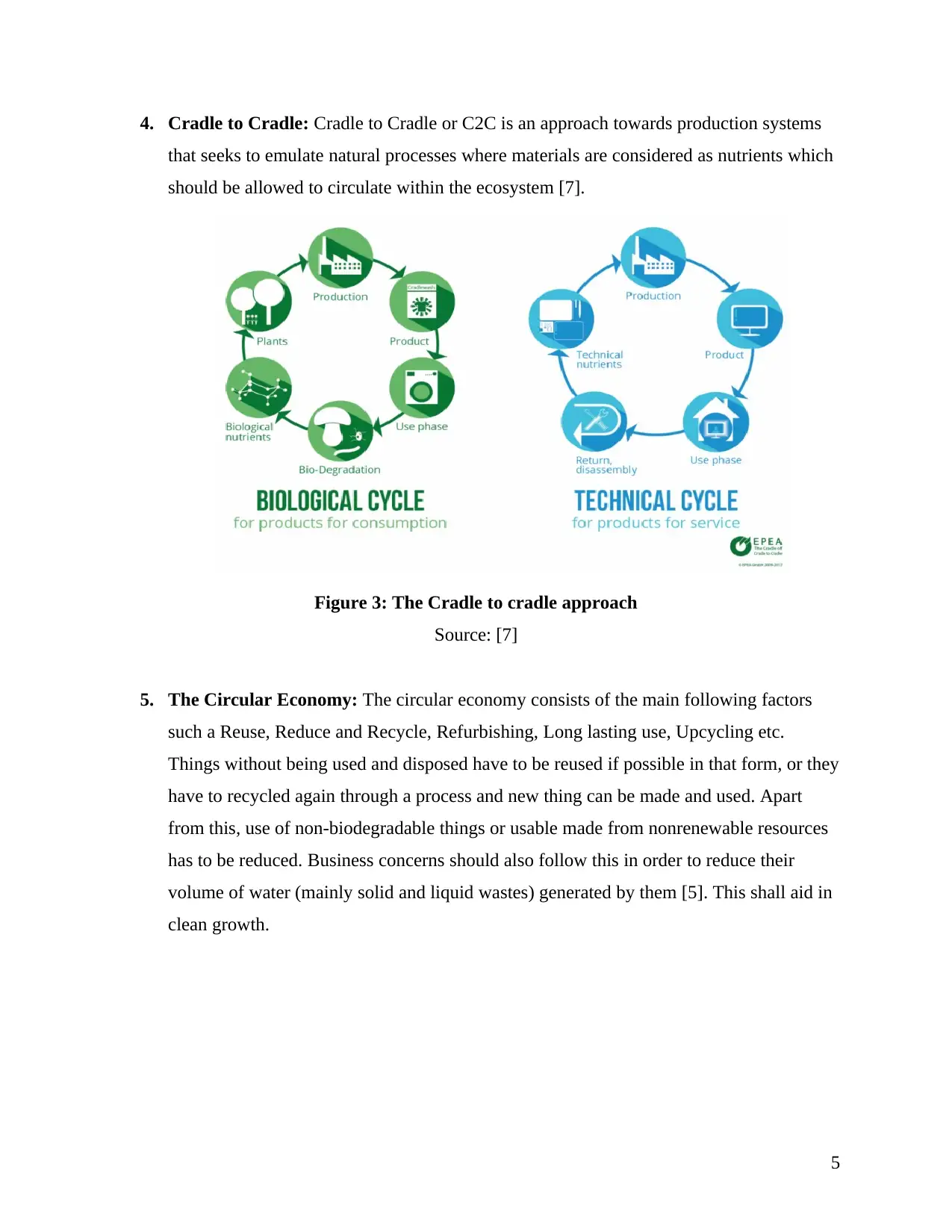
4. Cradle to Cradle: Cradle to Cradle or C2C is an approach towards production systems
that seeks to emulate natural processes where materials are considered as nutrients which
should be allowed to circulate within the ecosystem [7].
Figure 3: The Cradle to cradle approach
Source: [7]
5. The Circular Economy: The circular economy consists of the main following factors
such a Reuse, Reduce and Recycle, Refurbishing, Long lasting use, Upcycling etc.
Things without being used and disposed have to be reused if possible in that form, or they
have to recycled again through a process and new thing can be made and used. Apart
from this, use of non-biodegradable things or usable made from nonrenewable resources
has to be reduced. Business concerns should also follow this in order to reduce their
volume of water (mainly solid and liquid wastes) generated by them [5]. This shall aid in
clean growth.
5
that seeks to emulate natural processes where materials are considered as nutrients which
should be allowed to circulate within the ecosystem [7].
Figure 3: The Cradle to cradle approach
Source: [7]
5. The Circular Economy: The circular economy consists of the main following factors
such a Reuse, Reduce and Recycle, Refurbishing, Long lasting use, Upcycling etc.
Things without being used and disposed have to be reused if possible in that form, or they
have to recycled again through a process and new thing can be made and used. Apart
from this, use of non-biodegradable things or usable made from nonrenewable resources
has to be reduced. Business concerns should also follow this in order to reduce their
volume of water (mainly solid and liquid wastes) generated by them [5]. This shall aid in
clean growth.
5
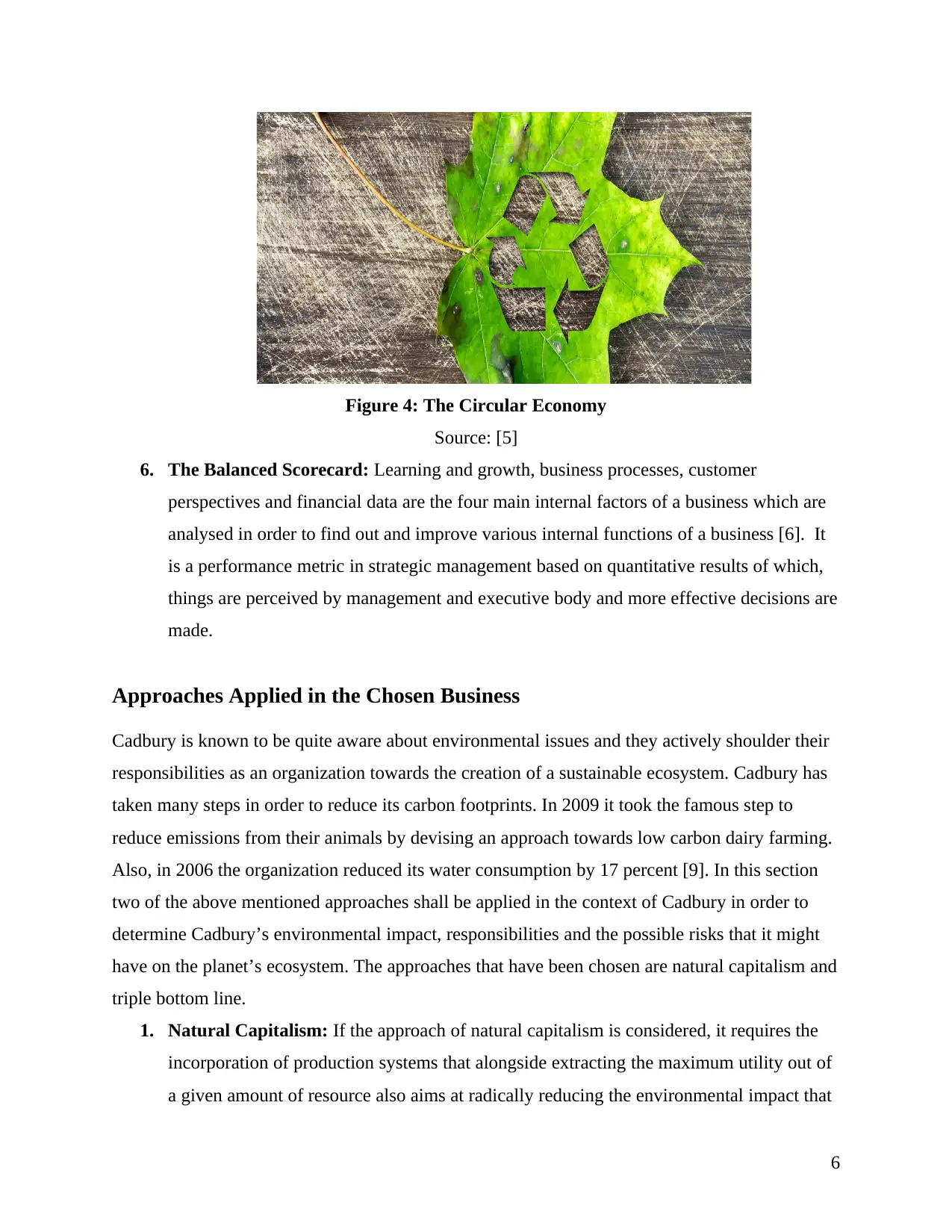
Figure 4: The Circular Economy
Source: [5]
6. The Balanced Scorecard: Learning and growth, business processes, customer
perspectives and financial data are the four main internal factors of a business which are
analysed in order to find out and improve various internal functions of a business [6]. It
is a performance metric in strategic management based on quantitative results of which,
things are perceived by management and executive body and more effective decisions are
made.
Approaches Applied in the Chosen Business
Cadbury is known to be quite aware about environmental issues and they actively shoulder their
responsibilities as an organization towards the creation of a sustainable ecosystem. Cadbury has
taken many steps in order to reduce its carbon footprints. In 2009 it took the famous step to
reduce emissions from their animals by devising an approach towards low carbon dairy farming.
Also, in 2006 the organization reduced its water consumption by 17 percent [9]. In this section
two of the above mentioned approaches shall be applied in the context of Cadbury in order to
determine Cadbury’s environmental impact, responsibilities and the possible risks that it might
have on the planet’s ecosystem. The approaches that have been chosen are natural capitalism and
triple bottom line.
1. Natural Capitalism: If the approach of natural capitalism is considered, it requires the
incorporation of production systems that alongside extracting the maximum utility out of
a given amount of resource also aims at radically reducing the environmental impact that
6
Source: [5]
6. The Balanced Scorecard: Learning and growth, business processes, customer
perspectives and financial data are the four main internal factors of a business which are
analysed in order to find out and improve various internal functions of a business [6]. It
is a performance metric in strategic management based on quantitative results of which,
things are perceived by management and executive body and more effective decisions are
made.
Approaches Applied in the Chosen Business
Cadbury is known to be quite aware about environmental issues and they actively shoulder their
responsibilities as an organization towards the creation of a sustainable ecosystem. Cadbury has
taken many steps in order to reduce its carbon footprints. In 2009 it took the famous step to
reduce emissions from their animals by devising an approach towards low carbon dairy farming.
Also, in 2006 the organization reduced its water consumption by 17 percent [9]. In this section
two of the above mentioned approaches shall be applied in the context of Cadbury in order to
determine Cadbury’s environmental impact, responsibilities and the possible risks that it might
have on the planet’s ecosystem. The approaches that have been chosen are natural capitalism and
triple bottom line.
1. Natural Capitalism: If the approach of natural capitalism is considered, it requires the
incorporation of production systems that alongside extracting the maximum utility out of
a given amount of resource also aims at radically reducing the environmental impact that
6
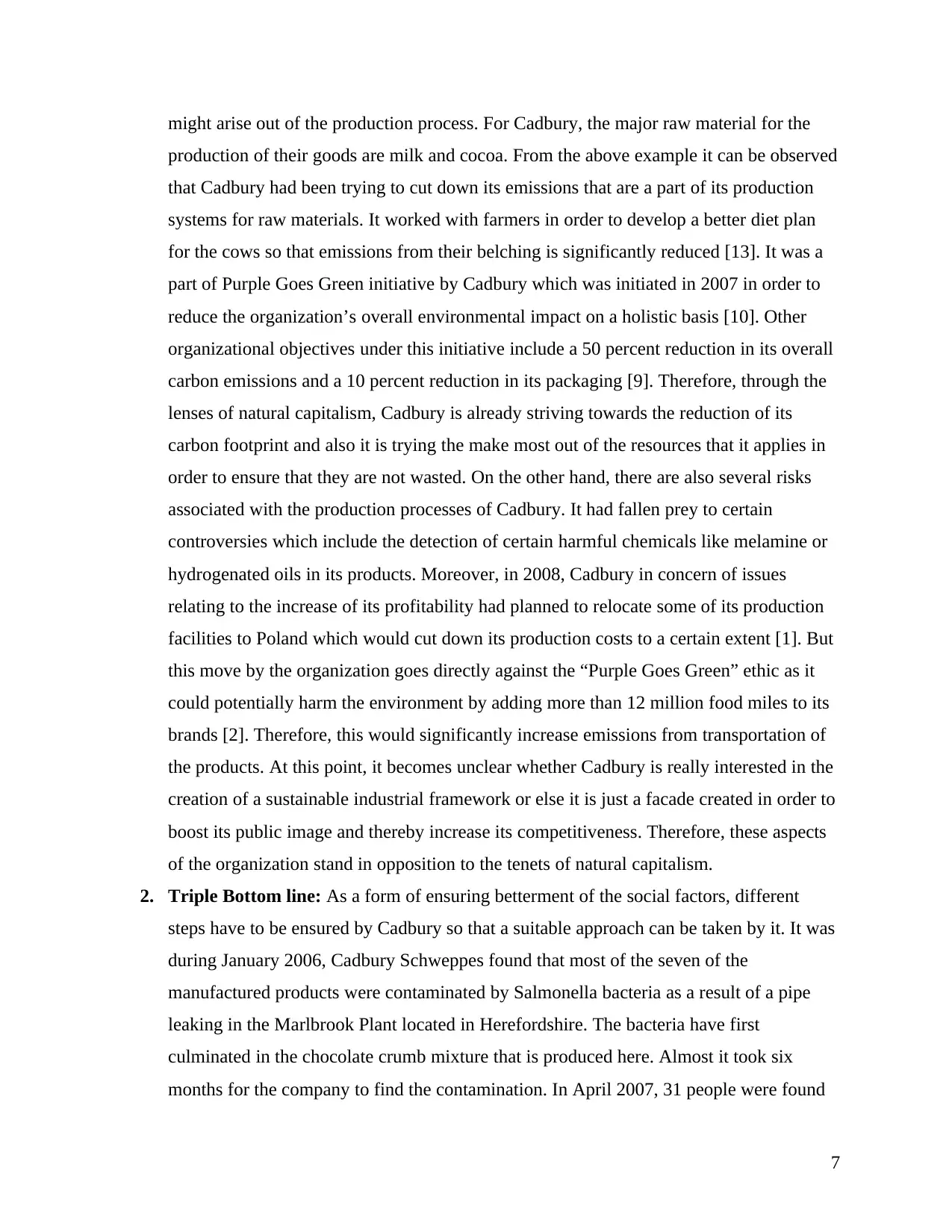
might arise out of the production process. For Cadbury, the major raw material for the
production of their goods are milk and cocoa. From the above example it can be observed
that Cadbury had been trying to cut down its emissions that are a part of its production
systems for raw materials. It worked with farmers in order to develop a better diet plan
for the cows so that emissions from their belching is significantly reduced [13]. It was a
part of Purple Goes Green initiative by Cadbury which was initiated in 2007 in order to
reduce the organization’s overall environmental impact on a holistic basis [10]. Other
organizational objectives under this initiative include a 50 percent reduction in its overall
carbon emissions and a 10 percent reduction in its packaging [9]. Therefore, through the
lenses of natural capitalism, Cadbury is already striving towards the reduction of its
carbon footprint and also it is trying the make most out of the resources that it applies in
order to ensure that they are not wasted. On the other hand, there are also several risks
associated with the production processes of Cadbury. It had fallen prey to certain
controversies which include the detection of certain harmful chemicals like melamine or
hydrogenated oils in its products. Moreover, in 2008, Cadbury in concern of issues
relating to the increase of its profitability had planned to relocate some of its production
facilities to Poland which would cut down its production costs to a certain extent [1]. But
this move by the organization goes directly against the “Purple Goes Green” ethic as it
could potentially harm the environment by adding more than 12 million food miles to its
brands [2]. Therefore, this would significantly increase emissions from transportation of
the products. At this point, it becomes unclear whether Cadbury is really interested in the
creation of a sustainable industrial framework or else it is just a facade created in order to
boost its public image and thereby increase its competitiveness. Therefore, these aspects
of the organization stand in opposition to the tenets of natural capitalism.
2. Triple Bottom line: As a form of ensuring betterment of the social factors, different
steps have to be ensured by Cadbury so that a suitable approach can be taken by it. It was
during January 2006, Cadbury Schweppes found that most of the seven of the
manufactured products were contaminated by Salmonella bacteria as a result of a pipe
leaking in the Marlbrook Plant located in Herefordshire. The bacteria have first
culminated in the chocolate crumb mixture that is produced here. Almost it took six
months for the company to find the contamination. In April 2007, 31 people were found
7
production of their goods are milk and cocoa. From the above example it can be observed
that Cadbury had been trying to cut down its emissions that are a part of its production
systems for raw materials. It worked with farmers in order to develop a better diet plan
for the cows so that emissions from their belching is significantly reduced [13]. It was a
part of Purple Goes Green initiative by Cadbury which was initiated in 2007 in order to
reduce the organization’s overall environmental impact on a holistic basis [10]. Other
organizational objectives under this initiative include a 50 percent reduction in its overall
carbon emissions and a 10 percent reduction in its packaging [9]. Therefore, through the
lenses of natural capitalism, Cadbury is already striving towards the reduction of its
carbon footprint and also it is trying the make most out of the resources that it applies in
order to ensure that they are not wasted. On the other hand, there are also several risks
associated with the production processes of Cadbury. It had fallen prey to certain
controversies which include the detection of certain harmful chemicals like melamine or
hydrogenated oils in its products. Moreover, in 2008, Cadbury in concern of issues
relating to the increase of its profitability had planned to relocate some of its production
facilities to Poland which would cut down its production costs to a certain extent [1]. But
this move by the organization goes directly against the “Purple Goes Green” ethic as it
could potentially harm the environment by adding more than 12 million food miles to its
brands [2]. Therefore, this would significantly increase emissions from transportation of
the products. At this point, it becomes unclear whether Cadbury is really interested in the
creation of a sustainable industrial framework or else it is just a facade created in order to
boost its public image and thereby increase its competitiveness. Therefore, these aspects
of the organization stand in opposition to the tenets of natural capitalism.
2. Triple Bottom line: As a form of ensuring betterment of the social factors, different
steps have to be ensured by Cadbury so that a suitable approach can be taken by it. It was
during January 2006, Cadbury Schweppes found that most of the seven of the
manufactured products were contaminated by Salmonella bacteria as a result of a pipe
leaking in the Marlbrook Plant located in Herefordshire. The bacteria have first
culminated in the chocolate crumb mixture that is produced here. Almost it took six
months for the company to find the contamination. In April 2007, 31 people were found
7
Paraphrase This Document
Need a fresh take? Get an instant paraphrase of this document with our AI Paraphraser

to be badly affected by the virus, while one person had to be hospitalized. As a result of
analysing and keeping with social bottom line ethics for sustainability, the company
recalled all of its seven products [9]. In 29th September 2008, the chocolates
manufactured in Beijing factory were found to be contaminated by melamine. The
products were also recalled for maintaining good terms in social bottom-line. It can be
well seen that for maintaining proper social welfare, the company has miserably failed in
this aspect and due to its carelessness, the contamination and degradation of food quality
has happened quite often. The company time and again has breached food safety
standards and manufactured products carelessly and gas earned huge profits. As a fact of
maintaining economic bottom line, the company even incurred costs of 30 million pounds
to get rid of contamination and paid 1 million pounds to all the people suffering from
health causes after consuming their products [12]. In case of maintaining a good
environmental bottom-line for prolonged sustainability, the company took steps to reduce
its water consumption. Allegations from various local and private bodies had come up
regarding the huge water contamination created by the company. The company looked
through the ecological factors and brought 17% decrease in water used by 2006 and by
2007, it started implementing various water conservation programmes as part of the
Purple Goes Green initiative to reduce water use by 100% [10]. The company also was
alleged for generating huge methane emission from the cows in the dairy farms from
which Cadbury took its raw milk. In order to solve the issue, the company aimed to
introduce low carbon dairy farming with the farmers so that a 50% reduction in carbon
and methane emission can be brought forth. After several complaints coming from
different bodies regarding the huge use of plastic for packaging purpose, the company has
brought a 78% reduction in use of plastic for packaging and 50% decrease in use of
cardboards [11].
Comparison of Approaches
While natural capitalism on one hand brings only the production processes and its relationship
with the ecological conditions under its purview, the approach of the triple bottom line consists
of three domains namely, the economic, social and the environmental. There is a possibility that
8
analysing and keeping with social bottom line ethics for sustainability, the company
recalled all of its seven products [9]. In 29th September 2008, the chocolates
manufactured in Beijing factory were found to be contaminated by melamine. The
products were also recalled for maintaining good terms in social bottom-line. It can be
well seen that for maintaining proper social welfare, the company has miserably failed in
this aspect and due to its carelessness, the contamination and degradation of food quality
has happened quite often. The company time and again has breached food safety
standards and manufactured products carelessly and gas earned huge profits. As a fact of
maintaining economic bottom line, the company even incurred costs of 30 million pounds
to get rid of contamination and paid 1 million pounds to all the people suffering from
health causes after consuming their products [12]. In case of maintaining a good
environmental bottom-line for prolonged sustainability, the company took steps to reduce
its water consumption. Allegations from various local and private bodies had come up
regarding the huge water contamination created by the company. The company looked
through the ecological factors and brought 17% decrease in water used by 2006 and by
2007, it started implementing various water conservation programmes as part of the
Purple Goes Green initiative to reduce water use by 100% [10]. The company also was
alleged for generating huge methane emission from the cows in the dairy farms from
which Cadbury took its raw milk. In order to solve the issue, the company aimed to
introduce low carbon dairy farming with the farmers so that a 50% reduction in carbon
and methane emission can be brought forth. After several complaints coming from
different bodies regarding the huge use of plastic for packaging purpose, the company has
brought a 78% reduction in use of plastic for packaging and 50% decrease in use of
cardboards [11].
Comparison of Approaches
While natural capitalism on one hand brings only the production processes and its relationship
with the ecological conditions under its purview, the approach of the triple bottom line consists
of three domains namely, the economic, social and the environmental. There is a possibility that
8
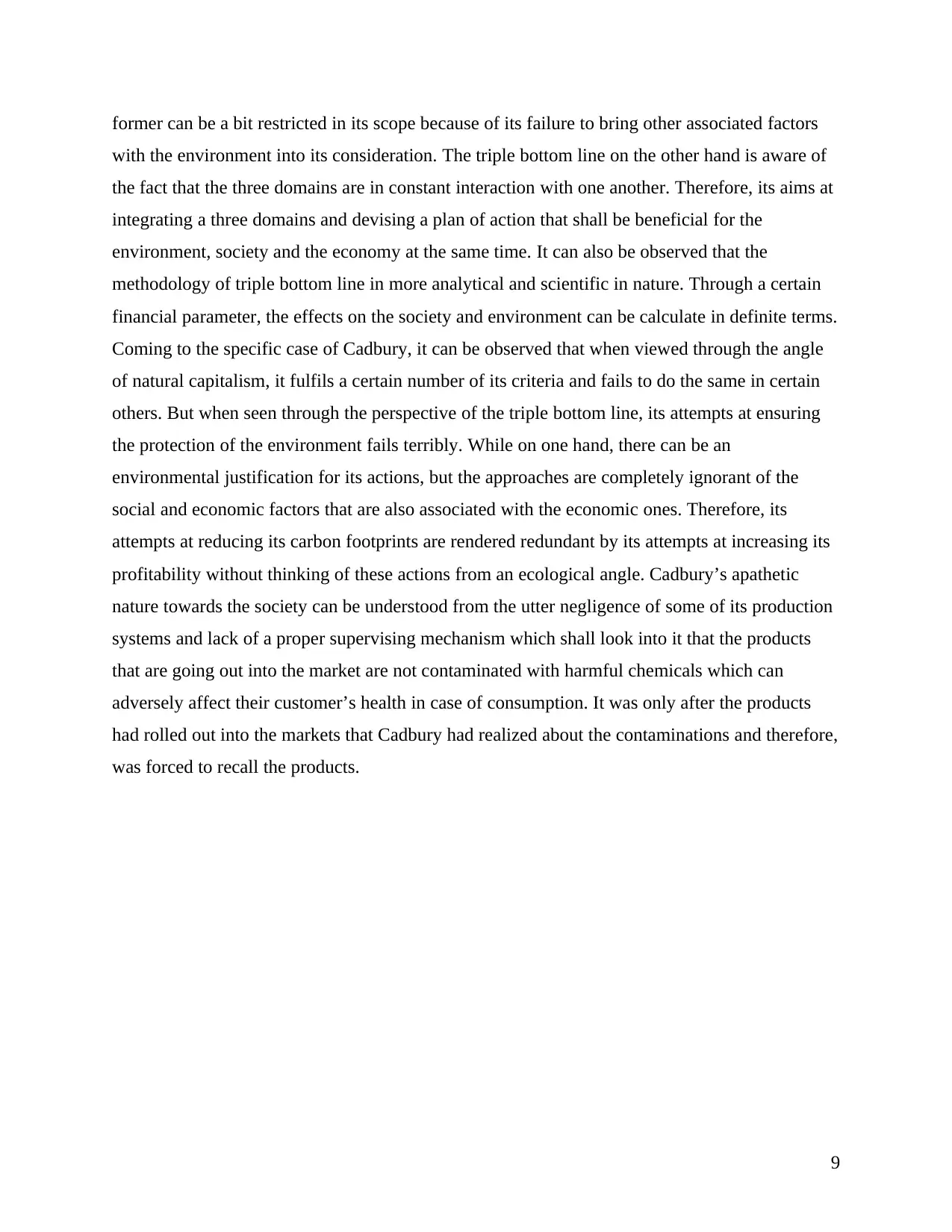
former can be a bit restricted in its scope because of its failure to bring other associated factors
with the environment into its consideration. The triple bottom line on the other hand is aware of
the fact that the three domains are in constant interaction with one another. Therefore, its aims at
integrating a three domains and devising a plan of action that shall be beneficial for the
environment, society and the economy at the same time. It can also be observed that the
methodology of triple bottom line in more analytical and scientific in nature. Through a certain
financial parameter, the effects on the society and environment can be calculate in definite terms.
Coming to the specific case of Cadbury, it can be observed that when viewed through the angle
of natural capitalism, it fulfils a certain number of its criteria and fails to do the same in certain
others. But when seen through the perspective of the triple bottom line, its attempts at ensuring
the protection of the environment fails terribly. While on one hand, there can be an
environmental justification for its actions, but the approaches are completely ignorant of the
social and economic factors that are also associated with the economic ones. Therefore, its
attempts at reducing its carbon footprints are rendered redundant by its attempts at increasing its
profitability without thinking of these actions from an ecological angle. Cadbury’s apathetic
nature towards the society can be understood from the utter negligence of some of its production
systems and lack of a proper supervising mechanism which shall look into it that the products
that are going out into the market are not contaminated with harmful chemicals which can
adversely affect their customer’s health in case of consumption. It was only after the products
had rolled out into the markets that Cadbury had realized about the contaminations and therefore,
was forced to recall the products.
9
with the environment into its consideration. The triple bottom line on the other hand is aware of
the fact that the three domains are in constant interaction with one another. Therefore, its aims at
integrating a three domains and devising a plan of action that shall be beneficial for the
environment, society and the economy at the same time. It can also be observed that the
methodology of triple bottom line in more analytical and scientific in nature. Through a certain
financial parameter, the effects on the society and environment can be calculate in definite terms.
Coming to the specific case of Cadbury, it can be observed that when viewed through the angle
of natural capitalism, it fulfils a certain number of its criteria and fails to do the same in certain
others. But when seen through the perspective of the triple bottom line, its attempts at ensuring
the protection of the environment fails terribly. While on one hand, there can be an
environmental justification for its actions, but the approaches are completely ignorant of the
social and economic factors that are also associated with the economic ones. Therefore, its
attempts at reducing its carbon footprints are rendered redundant by its attempts at increasing its
profitability without thinking of these actions from an ecological angle. Cadbury’s apathetic
nature towards the society can be understood from the utter negligence of some of its production
systems and lack of a proper supervising mechanism which shall look into it that the products
that are going out into the market are not contaminated with harmful chemicals which can
adversely affect their customer’s health in case of consumption. It was only after the products
had rolled out into the markets that Cadbury had realized about the contaminations and therefore,
was forced to recall the products.
9
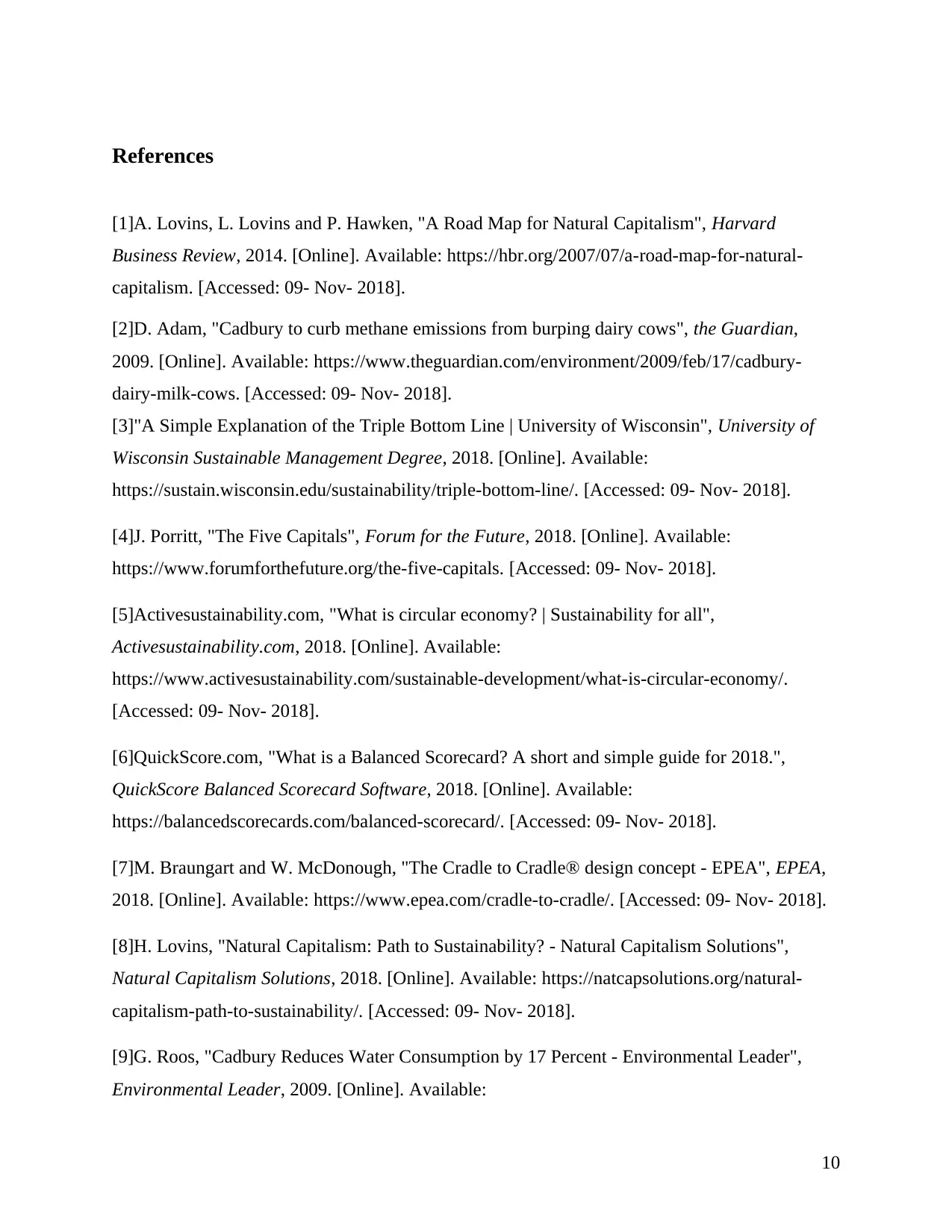
References
[1]A. Lovins, L. Lovins and P. Hawken, "A Road Map for Natural Capitalism", Harvard
Business Review, 2014. [Online]. Available: https://hbr.org/2007/07/a-road-map-for-natural-
capitalism. [Accessed: 09- Nov- 2018].
[2]D. Adam, "Cadbury to curb methane emissions from burping dairy cows", the Guardian,
2009. [Online]. Available: https://www.theguardian.com/environment/2009/feb/17/cadbury-
dairy-milk-cows. [Accessed: 09- Nov- 2018].
[3]"A Simple Explanation of the Triple Bottom Line | University of Wisconsin", University of
Wisconsin Sustainable Management Degree, 2018. [Online]. Available:
https://sustain.wisconsin.edu/sustainability/triple-bottom-line/. [Accessed: 09- Nov- 2018].
[4]J. Porritt, "The Five Capitals", Forum for the Future, 2018. [Online]. Available:
https://www.forumforthefuture.org/the-five-capitals. [Accessed: 09- Nov- 2018].
[5]Activesustainability.com, "What is circular economy? | Sustainability for all",
Activesustainability.com, 2018. [Online]. Available:
https://www.activesustainability.com/sustainable-development/what-is-circular-economy/.
[Accessed: 09- Nov- 2018].
[6]QuickScore.com, "What is a Balanced Scorecard? A short and simple guide for 2018.",
QuickScore Balanced Scorecard Software, 2018. [Online]. Available:
https://balancedscorecards.com/balanced-scorecard/. [Accessed: 09- Nov- 2018].
[7]M. Braungart and W. McDonough, "The Cradle to Cradle® design concept - EPEA", EPEA,
2018. [Online]. Available: https://www.epea.com/cradle-to-cradle/. [Accessed: 09- Nov- 2018].
[8]H. Lovins, "Natural Capitalism: Path to Sustainability? - Natural Capitalism Solutions",
Natural Capitalism Solutions, 2018. [Online]. Available: https://natcapsolutions.org/natural-
capitalism-path-to-sustainability/. [Accessed: 09- Nov- 2018].
[9]G. Roos, "Cadbury Reduces Water Consumption by 17 Percent - Environmental Leader",
Environmental Leader, 2009. [Online]. Available:
10
[1]A. Lovins, L. Lovins and P. Hawken, "A Road Map for Natural Capitalism", Harvard
Business Review, 2014. [Online]. Available: https://hbr.org/2007/07/a-road-map-for-natural-
capitalism. [Accessed: 09- Nov- 2018].
[2]D. Adam, "Cadbury to curb methane emissions from burping dairy cows", the Guardian,
2009. [Online]. Available: https://www.theguardian.com/environment/2009/feb/17/cadbury-
dairy-milk-cows. [Accessed: 09- Nov- 2018].
[3]"A Simple Explanation of the Triple Bottom Line | University of Wisconsin", University of
Wisconsin Sustainable Management Degree, 2018. [Online]. Available:
https://sustain.wisconsin.edu/sustainability/triple-bottom-line/. [Accessed: 09- Nov- 2018].
[4]J. Porritt, "The Five Capitals", Forum for the Future, 2018. [Online]. Available:
https://www.forumforthefuture.org/the-five-capitals. [Accessed: 09- Nov- 2018].
[5]Activesustainability.com, "What is circular economy? | Sustainability for all",
Activesustainability.com, 2018. [Online]. Available:
https://www.activesustainability.com/sustainable-development/what-is-circular-economy/.
[Accessed: 09- Nov- 2018].
[6]QuickScore.com, "What is a Balanced Scorecard? A short and simple guide for 2018.",
QuickScore Balanced Scorecard Software, 2018. [Online]. Available:
https://balancedscorecards.com/balanced-scorecard/. [Accessed: 09- Nov- 2018].
[7]M. Braungart and W. McDonough, "The Cradle to Cradle® design concept - EPEA", EPEA,
2018. [Online]. Available: https://www.epea.com/cradle-to-cradle/. [Accessed: 09- Nov- 2018].
[8]H. Lovins, "Natural Capitalism: Path to Sustainability? - Natural Capitalism Solutions",
Natural Capitalism Solutions, 2018. [Online]. Available: https://natcapsolutions.org/natural-
capitalism-path-to-sustainability/. [Accessed: 09- Nov- 2018].
[9]G. Roos, "Cadbury Reduces Water Consumption by 17 Percent - Environmental Leader",
Environmental Leader, 2009. [Online]. Available:
10
Secure Best Marks with AI Grader
Need help grading? Try our AI Grader for instant feedback on your assignments.
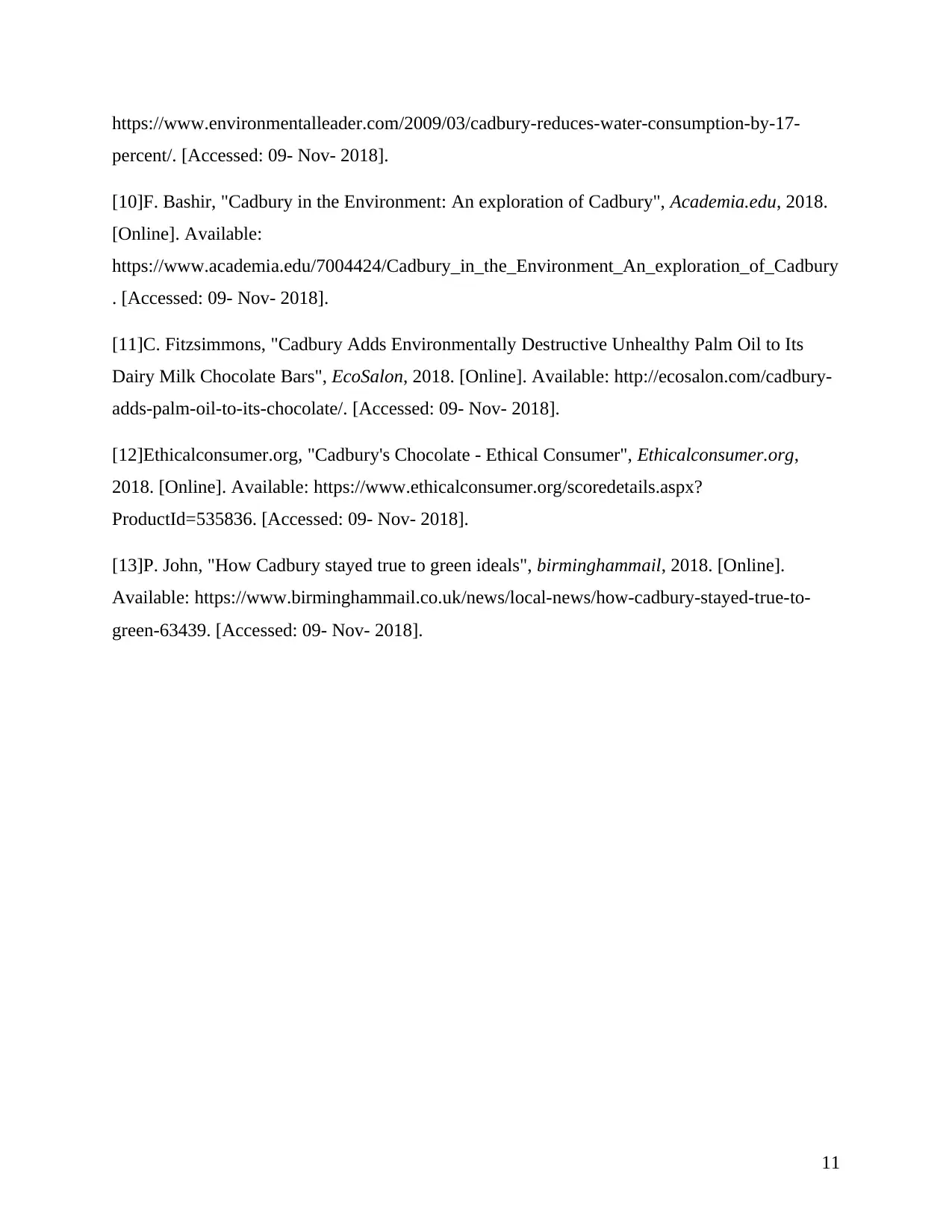
https://www.environmentalleader.com/2009/03/cadbury-reduces-water-consumption-by-17-
percent/. [Accessed: 09- Nov- 2018].
[10]F. Bashir, "Cadbury in the Environment: An exploration of Cadbury", Academia.edu, 2018.
[Online]. Available:
https://www.academia.edu/7004424/Cadbury_in_the_Environment_An_exploration_of_Cadbury
. [Accessed: 09- Nov- 2018].
[11]C. Fitzsimmons, "Cadbury Adds Environmentally Destructive Unhealthy Palm Oil to Its
Dairy Milk Chocolate Bars", EcoSalon, 2018. [Online]. Available: http://ecosalon.com/cadbury-
adds-palm-oil-to-its-chocolate/. [Accessed: 09- Nov- 2018].
[12]Ethicalconsumer.org, "Cadbury's Chocolate - Ethical Consumer", Ethicalconsumer.org,
2018. [Online]. Available: https://www.ethicalconsumer.org/scoredetails.aspx?
ProductId=535836. [Accessed: 09- Nov- 2018].
[13]P. John, "How Cadbury stayed true to green ideals", birminghammail, 2018. [Online].
Available: https://www.birminghammail.co.uk/news/local-news/how-cadbury-stayed-true-to-
green-63439. [Accessed: 09- Nov- 2018].
11
percent/. [Accessed: 09- Nov- 2018].
[10]F. Bashir, "Cadbury in the Environment: An exploration of Cadbury", Academia.edu, 2018.
[Online]. Available:
https://www.academia.edu/7004424/Cadbury_in_the_Environment_An_exploration_of_Cadbury
. [Accessed: 09- Nov- 2018].
[11]C. Fitzsimmons, "Cadbury Adds Environmentally Destructive Unhealthy Palm Oil to Its
Dairy Milk Chocolate Bars", EcoSalon, 2018. [Online]. Available: http://ecosalon.com/cadbury-
adds-palm-oil-to-its-chocolate/. [Accessed: 09- Nov- 2018].
[12]Ethicalconsumer.org, "Cadbury's Chocolate - Ethical Consumer", Ethicalconsumer.org,
2018. [Online]. Available: https://www.ethicalconsumer.org/scoredetails.aspx?
ProductId=535836. [Accessed: 09- Nov- 2018].
[13]P. John, "How Cadbury stayed true to green ideals", birminghammail, 2018. [Online].
Available: https://www.birminghammail.co.uk/news/local-news/how-cadbury-stayed-true-to-
green-63439. [Accessed: 09- Nov- 2018].
11
1 out of 11
![[object Object]](/_next/static/media/star-bottom.7253800d.svg)




